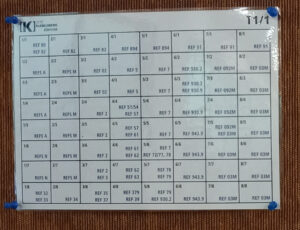- Home
- All Courses
- Contemporary library and information skills
Curriculum
- 9 Sections
- 31 Lessons
- 14 Weeks
- Introduction3
- 1) Library basicsThe main types of documents covered in these lessons, and the principles of the organisation and retrieval of library collections.3
- 2) Library use in the SZTE Klebelsberg LibraryThe chapter provides help on how to find and use the printed documents of the SZTE Klebelsberg Library, including the online options.6
- 3.1Video lesson: Library tour16 Minutes
- 3.2Video lesson: The SZTE Klebelsberg Library’s website9 Minutes
- 3.3Reading lesson: Printed documents in the SZTE Klebelsberg Library30 Minutes
- 3.4Reading lesson: Print periodicals30 Minutes
- 3.5Reading lesson: Encyclopedias and Lexicons – from glossaries to online forms30 Minutes
- 3.6Knowledge check – Library use23 Questions
- 3) Search the Library 1: online catalogue(s)This chapter covers the basics of database searching. It introduces the online catalogue of the SZTE Klebelsberg Library (Qulto), gives useful tips on how to use it more efficiently, and explains what you need to know about interlibrary loan.5
- 4.1Reading lesson: Library catalogues and electronic databases: basic search information25 Minutes
- 4.2Video lesson: SZTE Klebelsberg Library’s online catalogue: basics8 Minutes
- 4.3Video lesson: SZTE Klebelsberg Library’s online catalogue: extra features with registration10 Minutes
- 4.4Reading lesson: Interlibrary Loan, Combined Library Catalogues, and Metasearch Engines25 Minutes
- 4.5Knowledge check – Search 116 Questions
- 4) Search the Library 2: electronic resourcesThis chapter looks at searching the online resources provided by the SZTE Klebelsberg Library.8
- 5.1Reading lesson: Electronic resources in general20 Minutes
- 5.2Reading lesson: Electronic resources at the SZTE Klebelsberg Library25 Minutes
- 5.3Video lesson: Online resources – Summon Discovery8 Minutes
- 5.4Knowledge check – Search 2/a14 Questions
- 5.5Reading lesson: International databases15 Minutes
- 5.6Reading lesson: What to know about eBooks?30 Minutes
- 5.7Add-on: Google and others25 Minutes
- 5.8Knowledge check – Search 2/b12 Questions
- 5) Managing digital library content and community-based content developmentThis module presents repositories, the institutional digital collections specific to higher education libraries. In addition to a general introduction, special emphasis is given to SZTE Contenta, a repository system maintained by the SZTE Klebelsberg Library.5
- 6.1Reading lesson: Digital library contents: repositories30 Minutes
- 6.2Video lesson: Repositories of SZTE Klebelsberg Library: Contenta8 Minutes
- 6.3Reading-/video lesson: SZTE Klebelsberg Library Gallery and Media Library10 Minutes
- 6.4Add-on: Community-based Content Development20 Minutes
- 6.5Knowledge check – Digital library contents14 Questions
- 6) Academic writingThis module provides an insight into the criteria, characteristics and techniques of academic writing, the skills involved in collecting and managing literature, and the principles of scholarly writing.4
- 7) Writing history and librariesThis module gives an overview of the types of scripts and documents from different periods and the different types of libraries.4
- Glossary of terms1
Reading lesson: Encyclopedias and Lexicons – from glossaries to online forms
This lesson is about a special type of publication: encyclopaedias and lexicons. The overview ranges from glossaries to online encyclopaedias.
Encyclopedias vs. lexicons
What is the difference between them? A brief history of their origins and some famous examples.
The location of physical copies
Where are encyclopedias and lexicons stored in the Library and how can they be found?
Online platforms
Where and which encyclopedias and lexicons are available online?
Encyclopedias vs. lexicons
The history of encyclopedias and lexicons probably dates back to the time when the first efforts were made to collect and compile lists of technical terms related to particular fields of science. The products of such efforts were essentially the first glossaries*. In time, these glossaries were expanded and eventually combined to create lexicons and encyclopedias.
Glossary
A glossary is a list of terms typically used in a field of knowledge, with the meaning of each word explained.
Etymology and explanation
Lexicon
The word ‘lexicon’ is derived from the Greek word ‘lexis’ (word), meaning “a collection of words, glossary, dictionary”. In line with this definition, lexicons often aim to cover only a small range of topics, with relevant concepts defined in alphabetical order, just as they are in their predecessors, like glossaries.
Encyclopedia
The word ‘encyclopedia’ comes from the Greek term ‘enkyklios paideia’, meaning “complete general knowledge”. Encyclopedias tend to have extensive and comprehensive entries, which present information on any given subject in a way similar to how information is presented in scholarly works and monographies.
Originally, the term ‘encyclopedia’ referred to comprehensive works for general purposes, while the term ‘lexicon’ referred to more specialized collections. However, from the 19th century onwards, the two terms had begun to merge (cf. The Great Lexicon of Pallas: the encyclopedia of all knowledge).
Fun fact
The patron saint of internet users
Medieval scholars believed that the human mind is capable of processing the entirety of all the information provided to people by all the disciplines, and so they intended their encyclopedias to be textbooks and guides for people.
Isidore of Seville (c. 556–636) was a prominent ecclesiastical writer and teacher in medieval times. His most significant work is the 20-volume Etymologiae (600–625), which is a collection of information based on the pagan, classical, Christian, and Jewish knowledge of his time. The title of the work refers to Isidore’s main teaching and learning method, i.e., the studying and understanding of the origins and therefore the meaning of words. In the Middle Ages, this work was considered to be an encyclopedia of human knowledge. In those times, this encyclopedia played a role similar to the role of the internet today. That is why, in 1999, Pope John Paul II made St. Isidore of Seville the patron saint of internet users and people who are interested in science and technology.
Examples of printed encyclopedias
The following sections provide an overview of some encyclopedias and lexicons, discussing their evolution and significance.
Encyclopédie
The Renaissance, with the rediscovery of ancient authors and the flourishing of humanist ideas, saw the beginning of a process that led to the creation and publication of the French Encyclopédie, one of the greatest scholarly achievements of the Enlightenment era.
In intellectual terms, one of the most impressive achievements of the French Enlightenment is the publication of first edition of the Encyclopédie, with its 35 volumes, published between 1751 and 1772. However, as soon as it was completed, the demand for an expanded edition arose. This new edition was published in 166 volumes, between 1782 and 1832, with contributions by 2250 editors.
The publication of the Encyclopédie can also be considered a printing feat, as it was made in 4,250 copies, while, in the 18th century, it was rare even for single-volume works to be printed in more than 1,500 copies.
Encyclopædia Britannica
The Encyclopædia Britannica was founded in Edinburgh in 1768 and its latest printed edition (15th) was published in 2010. It started out in very modest circumstances: the first edition, published between 1768 and 1771, consisted of only three volumes (A-B, C-L and M-Z), with a total of 2391 pages. However, by 1797, when the third edition was completed, it had expanded to 18 volumes, covering what could be called a full range of subjects.
The Encyclopædia Britannica is also available in several national versions, including, Britannica Hungarica Világenciklopédia (18 volumes) and Britannica Hungarica Nagylexikon (25 volumes), which were published in Hungarian and cover additional subjects specific to Hungarian culture.
Brockhaus Enzyklopädie
The German-language Conversations-Lexicon was published in Leipzig between 1796 and 1808, originally only in 6 volumes. Similarly to other 18th century encyclopedias, its scope expanded rapidly in the pursuit of complete coverage. It was not primarily intended for scientific or scholarly use but to present research results and discoveries in a simple and popular way, without excessive detail.
This format, which differed significantly from that of the Encyclopædia Britannica, was widely copied by the publishers of other encyclopedias in 19th century. Consequently, this is the encyclopedia that bears the most similarities to the encyclopedias that came to be prevalent in the 20th century.
The encyclopedia was later renamed Der Große Brockhaus after the name of its publisher, with the title Brockhaus Enzyklopädie being used from the 17th edition on. The last printed edition (21st) was completed in 2014.
A reference library contains general and specialised lexicons and encyclopaedias as basic resources. In the SZTE Klebelsberg Library these works can be found on the shelves on the ground floor, in the Reference Section, at the beginning of the corridor on the right behind the Information Desk.
As in the specialised reading rooms, the volumes are arranged by subject and the call numbers can be found in our catalogue.
Ask the reference librarians for assistance.
Besides the lexicons and encyclopedias in the Reference Library, there are certain thematic collections in reading rooms which include lexicons and encyclopedias as well. These are the so-called ‘S’ collections (SL, SA, SB, SE, SO). As the picture shows, these are always the first items in a series of items on a given subject, and therefore serve as a starting point in terms of the call numbers assigned to items.
Online platforms
In view of the fact that an increasing number of encyclopedias and lexicons are available online, it is worth taking a closer look
The long-established Encyclopædia Britannica has been the world leader among English-language encyclopedias for over 250 years now. It is also the world’s first encyclopedia to be published online, available on the internet since 1994. The online version combines the strengths of print and online: the articles are written by experts, so readers get peer-reviewed and therefore reliable content, with all information constantly updated and widely accessible.
There are also a number of additional features that make the encyclopedia more interesting and useful:
- Infographics
- Highlights
- Videos
- Quizzes
- Dictionary, with English-language definitions
Encyclopedia.com is a website where the content of more than 200 encyclopedias and reference books are available. In terms of its design, it is very similar to Britannica Online, allowing users to browse materials by category or by focusing on specific concepts. It provides access to a significant number of publications published by the likes of Oxford University Press, Columbia University Press, and Cengage.
Finally, a few words about Wikipedia, today’s most famous and widely used online encyclopaedia, which is freeley available and built through community content development.
Wikipedia aims to fulfil the concept of an encyclopaedia, i.e. to make knowledge as widely known and accessible as possible. By 2025, it will contain nearly 7 million English-language entries.
Unlike its predecessors, it is not the work of a small number of experts, but the product of a large community. The aim of community content development is to enable as many people as possible to participate in the editing process, thereby striving for the most trustworthy content possible. In this spirit, Wikipedia articles are open to editing by anyone, and the content is public and subject to Creative Commons rules.
In recent years, the number of active editors reviewing content has been decreasing, which has led to an increase in the number of articles containing errors and misinformation.
So Wikipedia can be a good starting point, but a critical approach to all its claims is needed to check and confirm them with multiple scientific sources or databases.
Licences for the use of Wikipedia content
- GNU: text licence; the work can be freely distributed and edited as long as the original author is credited.
- Creative Commons: copyright term; allows owners of copyrighted works to transfer some of the protected rights to the community.
- Public domain: a concept relating to intellectual works, meaning a work of authorship for which the author does not impose any restrictions on its use.
The range of encyclopedias is vast because there are plenty of such collections, providing either broad coverage or focusing on specific areas. The following list is a good starting point for finding further information about encyclopedias available online. In addition, the following page may provide useful information on which encyclopedias are the most widely used among the wide range of online encyclopedias available.



